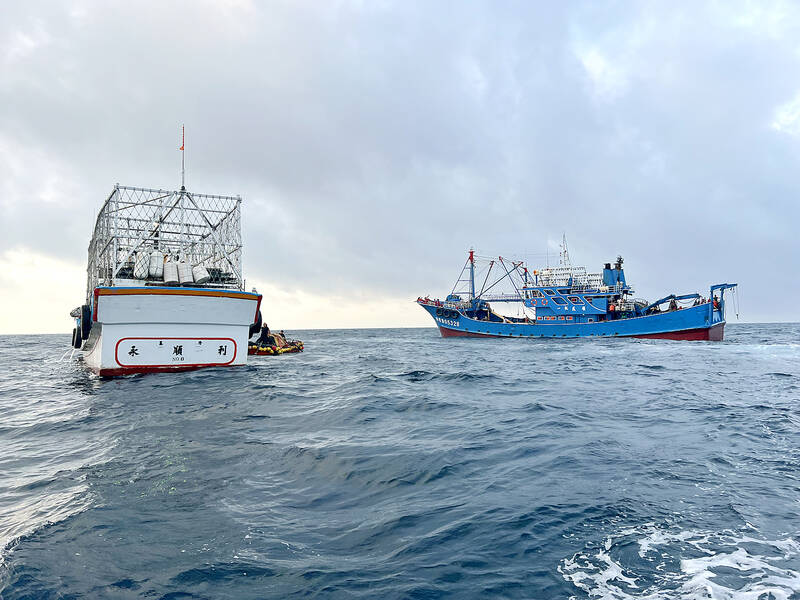The Coast Guard Administration (CGA) is to make it compulsory for all fishing vessels with gross tonnage under 20 tonnes to install an automatic identification system (AIS) by next year to prevent Chinese speedboat incursions.
CGA Director-General Chang Chung-lung (張忠龍) said his agency has been in talks with the Maritime Port Bureau and the Fisheries Agency to demand that all Taiwanese fishing vessels to install an AIS before the end of next year.
All Taiwanese offshore fishing vessels with gross tonnage of 20 tonnes or higher have already installed an AIS, an automatic tracking system that uses transceivers on ships and is used by vessel traffic services.

Photo courtesy of the Coast Guard Administration
Having all local fishing vessels install an AIS would make it easier for CGA personnel to spot non-Taiwanese vessels near harbors and ports, Chang said.
Chang mentioned the new initiative when asked by Democratic Progressive Party Legislator Wang Ting-yu (王定宇) what the CGA plans to do to keep Chinese speedboat incursions from happening.
The CGA is responsible for patrolling waters up to 24 nautical miles (44km) from the coast.
There have been at least four incidents involving Chinese nationals sailing speedboats into Taiwanese harbors without being detected in the past four years. The most recent case was in Kinmen on Monday.
Defense experts have repeatedly urged the government to be on high alert for similar incursions as they could be part of Chinese government tests of Taiwan’s coastal and harbor management.
The Shilin District Court last month sentenced a Chinese man who sailed a speedboat near the mouth of the Tamsui River in June to eight months in prison for breaching immigration law.
The Tamsui incident drew special attention because the river is considered a critical strategic location and serves as a gateway to Taipei, the nation’s political, economic and social capital, where the Presidential Office Building and other important government institutions are situated.
The CGA disciplined 10 people for allowing the Chinese speedboat to reach the mouth of the river.
At the time, the CGA admitted negligence in its failure to spot the speedboat, but argued that there were more than 30 vessels near Tamsui, which made it difficult to spot the Chinese boat.

US climber Alex Honnold is to attempt to scale Taipei 101 without a rope and harness in a live Netflix special on Jan. 24, the streaming platform announced on Wednesday. Accounting for the time difference, the two-hour broadcast of Honnold’s climb, called Skyscraper Live, is to air on Jan. 23 in the US, Netflix said in a statement. Honnold, 40, was the first person ever to free solo climb the 900m El Capitan rock formation in Yosemite National Park — a feat that was recorded and later made into the 2018 documentary film Free Solo. Netflix previewed Skyscraper Live in October, after videos

Starting on Jan. 1, YouBike riders must have insurance to use the service, and a six-month trial of NT$5 coupons under certain conditions would be implemented to balance bike shortages, a joint statement from transportation departments across Taipei, New Taipei City and Taoyuan announced yesterday. The rental bike system operator said that coupons would be offered to riders to rent bikes from full stations, for riders who take out an electric-assisted bike from a full station, and for riders who return a bike to an empty station. All riders with YouBike accounts are automatically eligible for the program, and each membership account

NUMBERS IMBALANCE: More than 4 million Taiwanese have visited China this year, while only about half a million Chinese have visited here Beijing has yet to respond to Taiwan’s requests for negotiation over matters related to the recovery of cross-strait tourism, the Tourism Administration said yesterday. Taiwan’s tourism authority issued the statement after Chinese-language daily the China Times reported yesterday that the government’s policy of banning group tours to China does not stop Taiwanese from visiting the country. As of October, more than 4.2 million had traveled to China this year, exceeding last year. Beijing estimated the number of Taiwanese tourists in China could reach 4.5 million this year. By contrast, only 500,000 Chinese tourists are expected in Taiwan, the report said. The report

Temperatures are forecast to drop steadily as a continental cold air mass moves across Taiwan, with some areas also likely to see heavy rainfall, the Central Weather Administration (CWA) said. From today through early tomorrow, a cold air mass would keep temperatures low across central and northern Taiwan, and the eastern half of Taiwan proper, with isolated brief showers forecast along Keelung’s north coast, Taipei and New Taipei City’s mountainous areas and eastern Taiwan, it said. Lows of 11°C to 15°C are forecast in central and northern Taiwan, Yilan County, and the outlying Kinmen and Lienchiang (Matsu) counties, and 14°C to 17°C